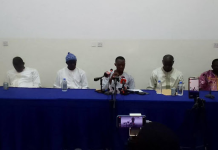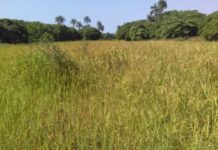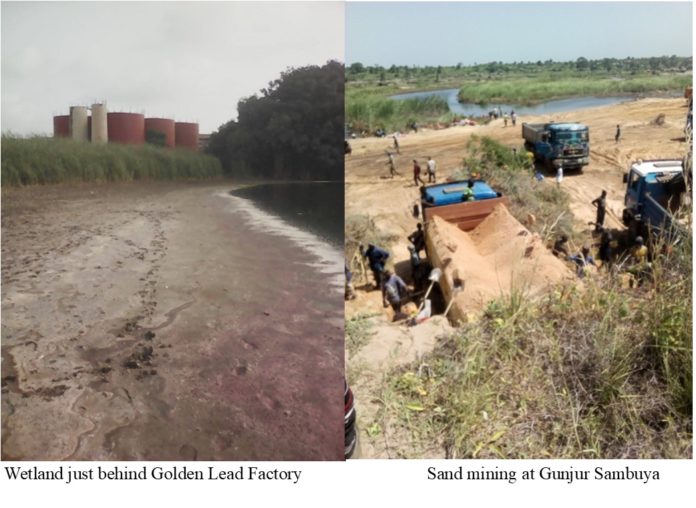With Madiba Singhateh
Welcome to another edition of the Environment Column. In Today’s column, we will look into the issue of sand mining and its toll on the environment and the country’s beaches. Among the latest incidents of sand mining is the one taking place at the Gunjur wetland, which is similar to the mining that occurred in Sanyang, Faraba Banta and Kitty.
The ‘Bolonyo Fenyo Wetland Wildlife Reserve is a 320-hectare land area that encompasses mix savannah of different species of plants and shrubs, sanctuary and habitat for birds, and a freshwater lagoon. Birdwatchers claim that some 150 species of birds are spotted every year, and the area is monitored by the Gunjur Environmental Protection and Development Group (GEPDG). However, reports have it that sand is being mined at the wetland reserve.
One Karamo Touray said a Chinese Factory, Golden Lead, is mining in the reserved land, and has seen them put sand mined from the wetland in several bags and take it to the factory, which is located just a few metres from the lagoon.
Badara Bajo, the Director of GEPDG said the area where this particular mining is taking place is within the wetland; adding that it is an area that turtles are very familiar with because it is their breeding place. Bajo said they do not know why Golden Lead is mining sand from the area and whether they have permission to do so and from which authority. He further said this is the second time such an activity is taking place at the site. Bajo said previously, the activity of the Chinese Company went to the extent of destroying mangroves within the wetland.
Bajo said mining sand in the Wetland can cause deforestation and coastal erosion which can have serious environmental impacts on people’s lives.
When this reporter visited the wetland reserve, no sand mining was taking place at the time. When contacted, Bajo said mining stopped when GEPDG started monitoring the activity of the Company. This reporter visited the Golden Lead Factory to get their viewpoint but he was not allowed in. Foroyaa will publish their views whenever they are willing to speak.
In the villages of Sanyang and Kitty:
This reporter visited the community of Sanyang where villagers continue to battle with authorities on the issue of sand mining within the coastal zone. This particular issue however is between the villages of Sanyang and National Environment Agency (NEA).
In their recent meeting, villagers told this reporter that the NEA expressed displeasure with the manner the Village Development Committee (VDC) is allowing mining in the area.
Fafanding Kinteh of the Coastal and Marine Unit of the Agency, said NEA has the mandate to regulate environmental malpractices in country. He warned that participating on such activity can cause Environmental degradation. However villagers indicated to this reporter that VDC Chairperson Lamin Bojang, denied the participation or involvement of villagers in any form of sand mining from the village; that they have always informed the NEA whenever they embark on carrying out such activities on the beach.
Meanwhile in Kitty, Cashew farmers complain of sand miners encroaching on their gardens and lands reserved for gardening. The Cashew farmers who could not hide their anger against these sand miners, said they have complained severally to the authorities but to no avail. Some have already fenced their gardens to avoid encroachment by these miners.
According to the National Environmental Management Act Part VII, the management of coastal zones on the river and wetland areas disallows mining or any other activity that will be detrimental to the environment. The law adds that no person may in relation to the coastal zone, river, tributary and any other wetland area, use, erect, reconstruct, place, alter, extend, remove or demolish any part of any structure in, on, under, or over the sea bed. It also adds that no one is to excavate, drill a tunnel or otherwise disturb or introduce or plant any type of plant whether alien or indigenous, which is likely to have adverse effects on the environment, river, lagoon or wetland.
Ahmed Manjang, a micro biologist who also shed light on the issue, said sand mining is a factor for coastal erosion, adding that the Gambia is below sea level and the sea level is also rising. Manjang said global warming and the melting of the ice in Greenland and Antarctica, is giving rise to the sea level including the Atlantic Ocean. Manjang said the more the sea level rises, the more it reaches land. Manjang said the Gambia has to explore mitigating factors like how to move back the ocean and planting coconuts along the coast line. that the dunes between the Ocean and Land, is meant to stop the Ocean from reaching further inland, noting that if the dunes are excavated, sea water will flow into the gardens at high tide through the river and this will affect the water table. The result is that salt intrusion will affect rice fields and gardens, rendering the area infertile.
Omar Sambou an Environmentalist, said the threat posed by sand mining is made even more critical given the significant rise in global sea levels in coming decades.
He said Government should recognise the local impact of sand mining and mining activities in many localities on the coastal zones. He said enforcement of protection has been problematic and there has been little pressure to stop the practices from local or international environmental groups in the country. He said that in Gunjur, the last sand dune is undergoing destruction, explaining that this should be a protected area between two ecological communities or eco systems and in some cases, aquatic and terrestrial ecosystems. ‘‘Failure to protect the area can lead to loss of vegetation, loss of gardens from where local women derive their livelihoods, salt water intrusion that can affect the water table, land degradation, and a rise in sea level,” he explained.
This reporter visited the NEA to get more information on the issue. However the Media Communications Officer could not be reached for comment.



















